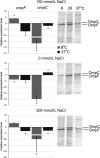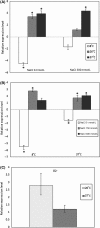Adaptive responses of outer membrane porin balance of Yersinia ruckeri under different incubation temperature, osmolarity, and oxygen availability
- PMID: 27038237
- PMCID: PMC4985593
- DOI: 10.1002/mbo3.354
Adaptive responses of outer membrane porin balance of Yersinia ruckeri under different incubation temperature, osmolarity, and oxygen availability
Abstract
The capability of Yersinia ruckeri to survive in the aquatic systems reflects its adaptation (most importantly through the alteration of membrane permeability) to the unfavorable environments. The nonspecific porins are a key factor contributing to the permeability. Here we studied the influence of the stimuli, such as temperature, osmolarity, and oxygen availability on regulation of Y. ruckeri porins. Using qRT-PCR and SDS-PAGE methods we found that major porins are tightly controlled by temperature. Hyperosmosis did not repress OmpF production. The limitation of oxygen availability led to decreased expression of both major porins and increased transcription of the minor porin OmpY. Regulation of the porin balance in Y. ruckeri, in spite of some similarities, diverges from that system in Escherichia coli. The changes in porin regulation can be adapted in Y. ruckeri in a species-specific manner determined by its aquatic habitats.
Keywords: Bacteria; environmental signal/stress responses; gene expression/regulation; outer membrane proteins; porins..
© 2016 The Authors. MicrobiologyOpen published by John Wiley & Sons Ltd.
Figures





Similar articles
-
A novel OmpY porin from Yersinia pseudotuberculosis: structure, channel-forming activity and trimer thermal stability.J Biomol Struct Dyn. 2011 Feb;28(4):517-33. doi: 10.1080/07391102.2011.10508592. J Biomol Struct Dyn. 2011. PMID: 21142221
-
Recombinant expression of Yersinia ruckeri outer membrane proteins in Escherichia coli extracellular vesicles.Protein Expr Purif. 2024 Mar;215:106409. doi: 10.1016/j.pep.2023.106409. Epub 2023 Nov 30. Protein Expr Purif. 2024. PMID: 38040272
-
Molecular Characterization, Phylogenetic, Expression, and Protective Immunity Analysis of OmpF, a Promising Candidate Immunogen Against Yersinia ruckeri Infection in Channel Catfish.Front Immunol. 2018 Sep 13;9:2003. doi: 10.3389/fimmu.2018.02003. eCollection 2018. Front Immunol. 2018. PMID: 30271401 Free PMC article.
-
Signal transduction and gene regulation through the phosphorylation of two regulatory components: the molecular basis for the osmotic regulation of the porin genes.Mol Microbiol. 1990 Jul;4(7):1077-82. doi: 10.1111/j.1365-2958.1990.tb00681.x. Mol Microbiol. 1990. PMID: 1700256 Review.
-
From acids to osmZ: multiple factors influence synthesis of the OmpF and OmpC porins in Escherichia coli.Mol Microbiol. 1996 Jun;20(5):911-7. doi: 10.1111/j.1365-2958.1996.tb02532.x. Mol Microbiol. 1996. PMID: 8809744 Review.
Cited by
-
secA, secD, secF, yajC, and yidC contribute to the adhesion regulation of Vibrio alginolyticus.Microbiologyopen. 2018 Apr;7(2):e00551. doi: 10.1002/mbo3.551. Epub 2017 Oct 23. Microbiologyopen. 2018. PMID: 29057613 Free PMC article.
-
Altered Outer Membrane Transcriptome Balance with AmpC Overexpression in Carbapenem-Resistant Enterobacter cloacae.Front Microbiol. 2016 Dec 23;7:2054. doi: 10.3389/fmicb.2016.02054. eCollection 2016. Front Microbiol. 2016. PMID: 28066375 Free PMC article.
-
Establishing Halomonas as a chassis for industrial biotechnology: advances in synthetic biology tool development and metabolic engineering strategies.Microb Cell Fact. 2025 Jun 12;24(1):133. doi: 10.1186/s12934-025-02757-2. Microb Cell Fact. 2025. PMID: 40506695 Free PMC article. Review.
-
Differential Expression of Yersinia pseudotuberculosis General Porin Genes during Short- and Long-Term Antibiotic Stresses.Molecules. 2021 Jun 28;26(13):3956. doi: 10.3390/molecules26133956. Molecules. 2021. PMID: 34203552 Free PMC article.
-
The RNA Chaperone Hfq and Small Non-Coding RNAs Modulate the Biofilm Formation of the Fish Pathogen Yersinia ruckeri.Int J Mol Sci. 2025 May 15;26(10):4733. doi: 10.3390/ijms26104733. Int J Mol Sci. 2025. PMID: 40429875 Free PMC article.
References
-
- Andersen, J. , Forst S. A., Zhao K., Inouye M., and Delihas N.. 1989. The function of micF RNA. micF RNA is a major factor in the thermal regulation of OmpF protein in Escherichia coli . J. Biol. Chem. 264:17961–17970. - PubMed
-
- Austin, B. , and Austin D. A.. 1987. Yersinia ruckeri Pp: 207–224 in: Bacterial fish pathogens: Disease in farmed and wild fish. John Wiley and Sons, New York.
-
- Begic, S. , and Worobec E. A.. 2006. Regulation of Serratia marcescens ompF and ompC porin genes in response to osmotic stress, salicylate, temperature and pH. Microbiology 152:485–491. - PubMed
-
- Bystritskaya, E. P. , and Stenkova A. M., Portnyagina Olu, Rakin A. V., Isaeva M. P..2014. Regulation of Yersinia pseudotuberculosis major porin expression in response to antibiotic stress. Mol. Gen. Microbiol. Virol. 29:63–68. - PubMed
MeSH terms
Substances
LinkOut - more resources
Full Text Sources
Other Literature Sources

